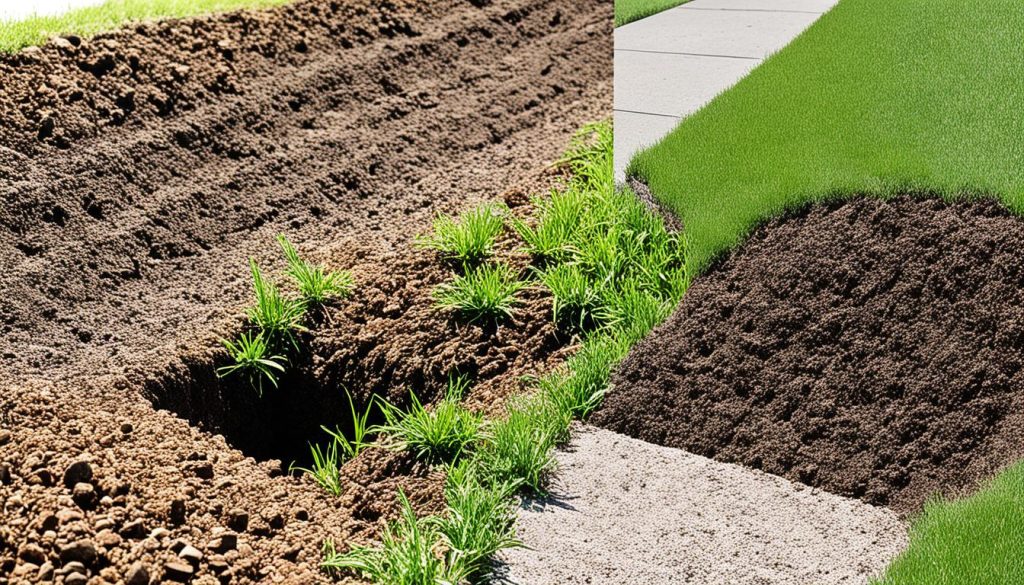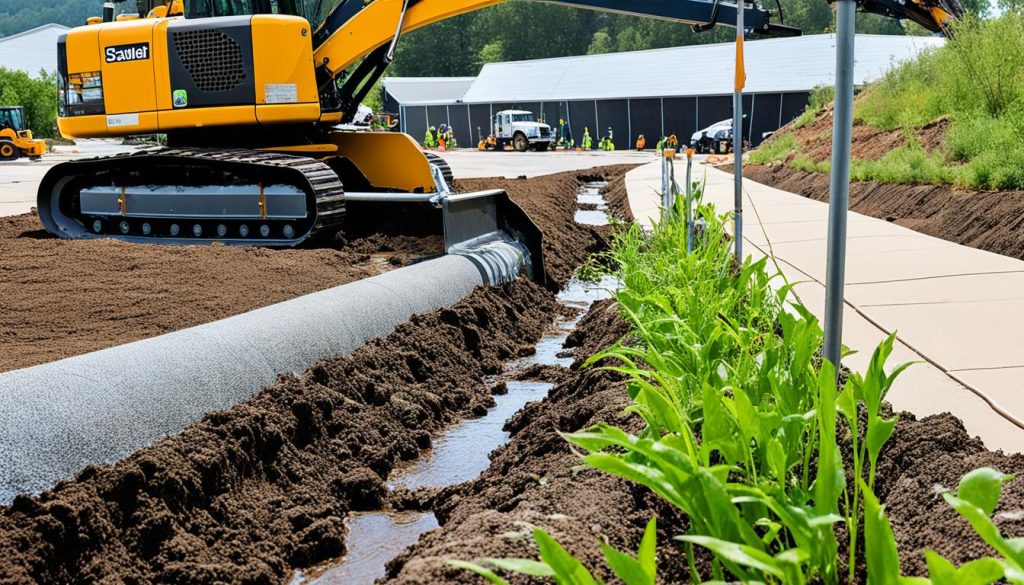Swale Drain Explained: Purpose and Benefits
Did you know that a properly designed swale drain can prevent erosion, flooding, and soil saturation on construction sites and properties? Swales are an integral part of effective stormwater management, redirecting surface water runoff and safeguarding buildings and infrastructure.
Swales are shallow, broad channels that collect and redirect water, controlling its flow and preventing damage. But their benefits go beyond flood prevention. Swale drains can also reduce maintenance costs, improve biodiversity, promote sustainability, and enhance the overall aesthetics of an area.
Key Takeaways:
- A swale drain is a landscape feature designed to manage water flow and drainage.
- Its purpose is to prevent erosion, flooding, and soil saturation.
- Swales offer benefits such as reduced maintenance costs, improved biodiversity, sustainability, and enhanced aesthetics.
- They can be designed in various shapes and sizes, incorporating native plants to absorb excess water and filter pollutants.
- Proper swale drain construction and maintenance are crucial for effective stormwater management.
Swale Drain Construction: Design and Maintenance
When it comes to constructing a swale drain, careful planning and consideration are essential to ensure its effectiveness. Here, I will discuss the key factors involved in swale drain construction, including location, slope, dimensions, and vegetation. Additionally, I will outline important maintenance tasks needed to keep swale drains functioning optimally.
Location and Slope
The location of a swale drain is crucial to its efficiency. It should be positioned at the lowest point of the area it serves, allowing for the natural flow of water. By directing water towards the swale, it can effectively collect and redirect surface runoff.
Furthermore, the slope of the swale drain is critical in maintaining proper water flow. It should be designed with a consistent slope that ensures water moves in the desired direction. This slope should be carefully calculated to promote water retention during heavy storms while still allowing for rapid drainage when necessary.
Dimensions and Vegetation
Proper design dimensions are essential to ensure the swale drain functions effectively. The dimensions should strike a balance between water retention and rapid flow, allowing the swale to efficiently collect and divert runoff. The exact dimensions will depend on the specific needs and characteristics of the site.
Vegetation plays a vital role in swale function. The use of native plants helps absorb excess water, prevent erosion, and filter pollutants. These plants should be carefully selected to match the local ecosystem and the swale’s purpose. Incorporating vegetation adds aesthetic value to the swale drain and creates a natural and sustainable drainage system.
Swale Drain Maintenance
Maintaining swale drains is key to their long-term effectiveness. Regular maintenance tasks include:
- Weed control: Regularly removing weeds and invasive plants prevents them from impeding water flow and ensures optimal swale performance.
- Debris removal: Clearing debris such as leaves, branches, and trash from the swale drain prevents clogging and maintains proper water flow.
- Grading: Periodically inspecting and grading the swale drain to ensure its slope remains consistent and optimal for water flow.
By regularly performing these maintenance tasks, you can ensure that your swale drain continues to function effectively and provides the desired drainage benefits.
| Key Considerations | Benefits |
|---|---|
| Proper location | Prevents erosion and flooding |
| Optimal slope | Controls water flow direction |
| Appropriate dimensions | Ensures water retention and rapid drainage |
| Native vegetation | Absorbs excess water and filters pollutants |
| Regular maintenance | Prevents clogging and maintains efficiency |
Swale Drain vs French Drain: A Comparison
When it comes to drainage systems, two popular options are swale drains and French drains. While they both serve the purpose of redirecting water, there are significant differences in their design and function.
A swale drain is a shallow, broad channel that collects and redirects surface water runoff. It is typically visible and can add aesthetic appeal to an area. On the other hand, a French drain is an underground trench filled with gravel or rock that collects and redirects subsurface water. It is hidden and often used in areas with poor soil drainage.
The choice between a swale drain and a French drain depends on the specific needs and characteristics of the site. Swale drains are ideal for managing surface water runoff and preventing erosion and flooding. They are suitable for areas where visual appeal is a priority and where the soil allows for effective surface drainage.
French drains, on the other hand, are ideal for managing subsurface water and preventing waterlogging. They are effective in areas with poor soil drainage, as they help redirect water away from structures and prevent moisture-related damage. French drains are often used in basement waterproofing and foundation drainage systems.
In summary, the main differences between swale drains and French drains lie in their visibility, function, and suitability for specific site conditions. Swale drains are visible and offer aesthetic appeal, while French drains are hidden and used for subsurface water management. Choosing the right drainage system depends on the goals and characteristics of the site.
Swale Drain vs French Drain: A Comparison
| Swale Drain | French Drain |
|---|---|
| Shallow, broad channel that collects surface water runoff | Underground trench that collects subsurface water |
| Visible and can add aesthetic appeal | Hidden underground |
| Effective for managing surface water runoff and preventing erosion and flooding | Effective for managing subsurface water and preventing waterlogging |
| Suitable for areas with soil that allows for effective surface drainage | Suitable for areas with poor soil drainage |
Swale Drain and Stormwater Management in Construction
Swale drains play a vital role in stormwater management on construction sites, offering numerous benefits for both the environment and the project’s success. As an eco-friendly solution, swale drains help prevent erosion and floods by effectively directing stormwater away from structures. By reducing the speed and volume of water runoff, swales protect buildings and infrastructure from damage.
One of the key advantages of swale drains is their natural filtration properties. As stormwater flows through the swale, it passes through vegetation and soil, which act as filters, removing pollutants. This filtration process helps prevent water pollution and improves overall water quality. Implementing swale drains in construction sites promotes sustainable drainage systems (SuDS) by effectively managing stormwater and minimizing the negative impact on surrounding ecosystems.
Integrating swale drains with other sustainable drainage systems enhances the effectiveness of stormwater management. By incorporating features such as permeable pavements and rain gardens, a comprehensive and integrated approach can be achieved. This combination maximizes the benefits of the swale drain system, ensuring efficient water retention, filtration, and absorption.
In addition to their environmental benefits, swale drains offer practical advantages that contribute to the success of construction projects. By mitigating erosion and controlling floods, swales minimize the need for expensive repairs and maintenance. They also contribute to eco-friendly practices, which align with sustainable building initiatives and promote a positive image for construction companies.
To summarize, the implementation of swale drains in construction sites is a smart choice for effective stormwater management. The swale drainage system’s ability to prevent erosion, control floods, and act as a natural filter for pollutants make it an excellent eco-friendly solution. By incorporating swale drains and other sustainable drainage systems, construction projects can achieve comprehensive stormwater management, contributing to a more sustainable and environmentally-friendly future.
Swale Drain in Roadside Ditches: Benefits and Considerations
Swales are highly advantageous in managing stormwater runoff in roadside ditches. These landscape features play a crucial role in not only conveying but also treating the runoff, resulting in numerous benefits for roadways and the surrounding environment.
Benefits of Swale Drains in Roadways
1. Reduced Runoff: Swale drains effectively detain, filter, and infiltrate stormwater runoff, reducing its volume and preventing excessive runoff from overwhelming watercourses or stormwater management facilities. This prevents localized flooding and ensures water is safely managed.
2. Improved Water Quality: Swales act as natural filters, removing pollutants and sediments from the runoff before it reaches water bodies. This helps maintain the quality of the water and minimizes the pollution of rivers, lakes, and other natural water sources.
3. Aesthetic Value: Incorporating swales in roadside ditches adds an attractive element to the roadway landscape. With the integration of native plants and vegetation, swales can enhance the visual appeal of the area and contribute to a more pleasant and inviting environment for both drivers and pedestrians.
Considerations for Swale Drains in Roadside Ditches
Maintenance is crucial to ensure the effectiveness and longevity of swale drains in roadside ditches. Regular upkeep tasks include:
- Litter and Debris Removal: Regularly clearing the swale drains of litter, leaves, and other debris ensures unobstructed water flow and prevents clogging.
- Grass Cutting: Keeping the grass and vegetation in the swales well-maintained allows for optimal performance and prevents overgrowth that could impede water flow.
- Repair of Eroded Areas: Monitoring and repairing any eroded areas in the swale drains is essential to maintain their functionality and prevent erosion from compromising the integrity of the roadside ditches.
By addressing these considerations, swale drains in roadside ditches can continue to provide their numerous benefits, contributing to effective stormwater management and sustainable roadway infrastructure.
The Science Behind Swale Construction and Function
Swales play a crucial role in an effective drainage system, controlling the flow of water and preventing flooding and erosion. These landscape features are specifically designed to collect, redirect, and gradually release stormwater runoff, ensuring its proper management. Swales can be constructed using different materials and can be either dry or wet, depending on the specific requirements of the site.
Constructing swales involves careful consideration of various factors, including the location, slope, dimensions, vegetation, and maintenance. By strategically positioning swales at the lowest points of the area, they effectively collect and redirect water flow. The slope determines the direction of water movement, ensuring efficient drainage. Additionally, swale dimensions are designed to allow for adequate water retention during heavy storms.
The science behind swale construction also incorporates the use of vegetation. Native plants are commonly incorporated into swales to aid in water absorption and pollutant filtration. These plants help slow down the flow of water, allowing for better infiltration and reducing the risk of erosion. Furthermore, maintaining swales is essential for their long-term functionality. Regular maintenance tasks include weed control, debris removal, and grading to ensure optimal performance.
Swales are not only cost-effective and environmentally friendly, but they also play a critical role in flood control. By effectively managing water runoff, swales help prevent erosion and flooding, protecting buildings and infrastructure. Moreover, the inclusion of swales in construction projects can enhance the aesthetic value of an area, contributing to its overall appeal. Understanding the science behind swales is essential for incorporating these effective drainage systems into construction projects and achieving successful stormwater management.
- Investing Wisely: How Windows & Doors in Boost Property Value and Financial Health - April 24, 2025
- The Financial Impact of Personal Injuries: Why Legal Help Matters for Business Owners - April 16, 2025
- The Hidden Financial Costs of Domestic Assault: What Business Owners Need to Know - April 16, 2025














